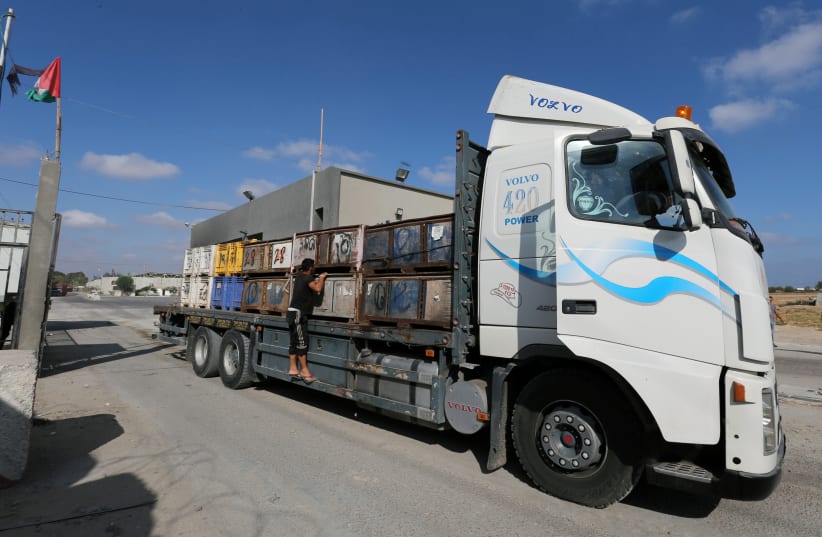A Related Video You May Like:
Despite apparent progress in the talks, violent clashes again broke out over the weekend in the latest installment of the Hamas-initiated "March of Return" protests. Chaos erupted along the border when an estimated 8,000 Palestinians began burning tires and hurling rocks and explosives at Israel Defense Forces troops, leading to the killing by live-fire of two Gazans and injuries to over 200 others. Dozens of incendiary objects continued to be launched into southern Israel, causing further damage to an already ravaged ecosystem.Notably, senior Hamas figures participated in the demonstrations, including Gaza leader Yahya Sinwar and the terror group’s deputy chief Saleh al-Arouri, who lives in exile but was granted special permission by Israel to enter the enclave in order to discuss with officials details of the prospective five-year ceasefire. That al-Arouri was allowed into Gaza despite being accused of directing attacks against Israel from Turkey is additional evidence that the diplomatic process has reached a critical juncture. Likewise, Sinwar's appearance Friday might be viewed as a final show of "resistance" ahead of a potential agreement.According to Brig. Gen. (res.) Nitzan Nuriel, former director of the Counter-Terrorism Bureau at the Israeli Prime Minister's Office and prior to that deputy commander of the IDF's Gaza Division, the present initiative may, after numerous previous failed attempts, bear fruit."Before determining if such will be the case, we need to understand the background on the Palestinian side," he explained to The Media Line. "Sinwar sat in an Israeli prison for 22 years and his generation knows very well that Hamas cannot defeat Israel. So they are more willing to compromise. But before this can happen Hamas needed to put up a fight and this is what has been happening for the past four months."The message to the people of Gaza," Nuriel elaborated, "is that Hamas won by setting fire to Israeli communities and killing an Israeli soldier. Now, they can consider a truce. This does not mean that Hamas will like or accept Israel, only that an accord is possible."Nevertheless, there are already signs that integral parts of the proposal may be bound to fail. For example, Abbas' Fatah faction this weekend called on Hamas to reject any long-term pact, which was described as a “free gift to Israel and another coup against the Palestinian people and their homeland.” Nor does it appear that Israel will agree to fully open up Gaza to the world—which is tantamount to throwing Hamas a lifeline—without any guarantees for when the deal expires."Any arrangement involves two basic components," Brig. Gen. (res.) Michael Herzog, former head of the IDF's Strategic Planning Division and a participant in most of Israel's peace negotiations with the Palestinians, contended to The Media Line. "As regards the first, Hamas must stop sending rockets and incendiary objects into Israel as well as building [cross-border] tunnels. Hamas ties this to the second element," he expounded, "which is economic recovery for Gaza. In this respect, there may be a problem due to countries' hesitance to throw good money after a bad cause. To date, many have been reluctant to do so for reasons ranging from not wanting to deepen the Palestinian divide or be seen as empowering Hamas.Equally crucial, according to Herzog, is the PA's reluctance to assume responsibility for Gaza's rehabilitation, especially while Hamas is still refusing to disarm. "More than that, the PA has imposed sanctions on Hamas. Both sides have their own conditions for reconciliation and have been unable to [bridge their differences] many times before. Overall, based on my knowledge, I'm not sure that this attempt is more likely to work than previous ones."The major unknown remains the Trump administration's much-anticipated peace plan, which reportedly is being prepared for roll-out and may contain components that fundamentally upend the status quo.What is definitive is that the prevailing situation is complex, and unless all of the pieces of the puzzle come together—which has not happened in the past—the ceasefire proposal may amount to nothing more than a period of relative quiet for Israel and a temporary reprieve for Hamas.This all-too-familiar dynamic has defined the past decade, resulting neither in long-term peace or an improvement in the humanitarian conditions in Gaza.For more stories go to themedialine.org
The Gaza Conundrum: Debating the merits of an Israel-Hamas ceasefire
What might be in store for the Gaza Strip?
